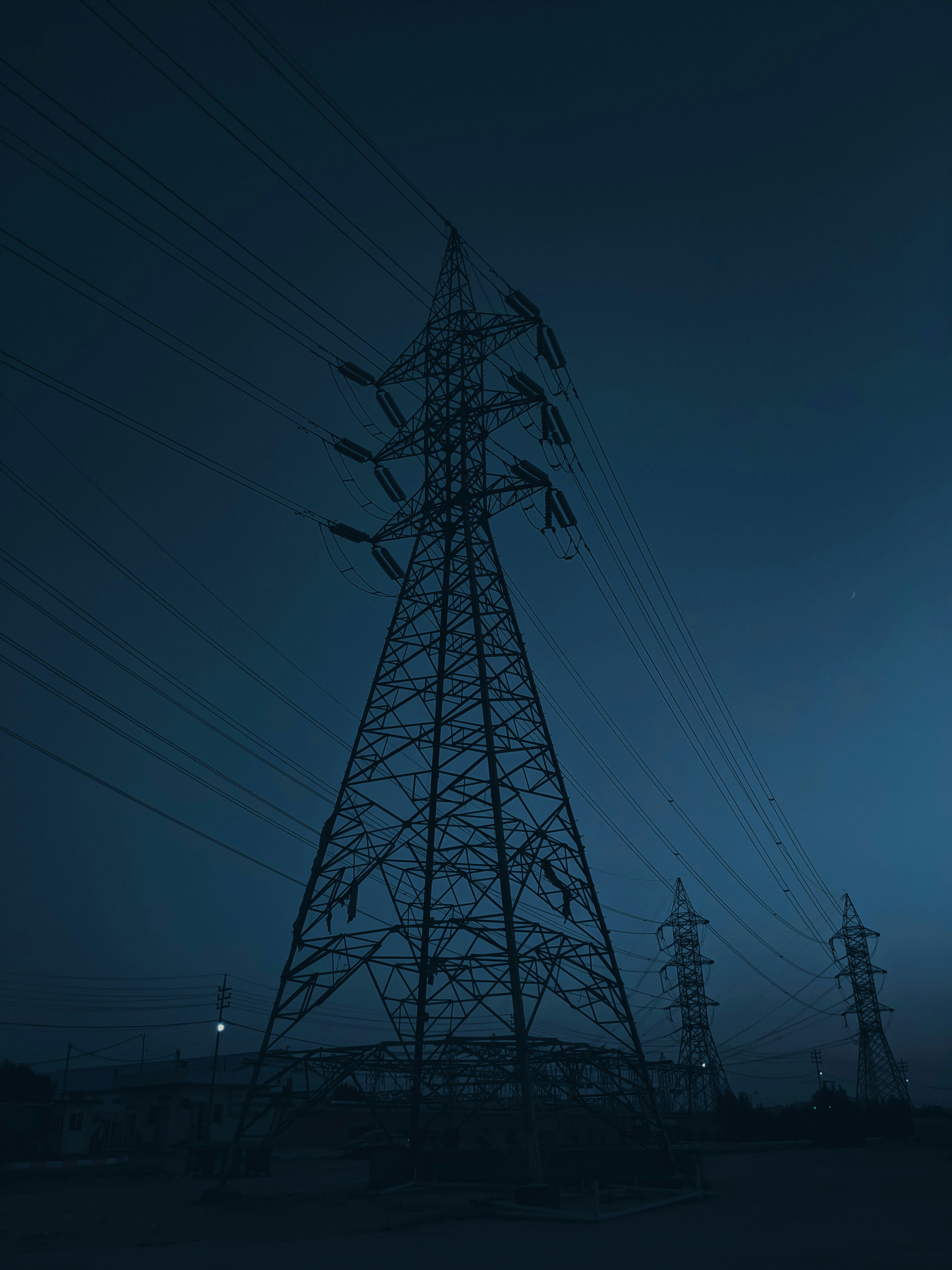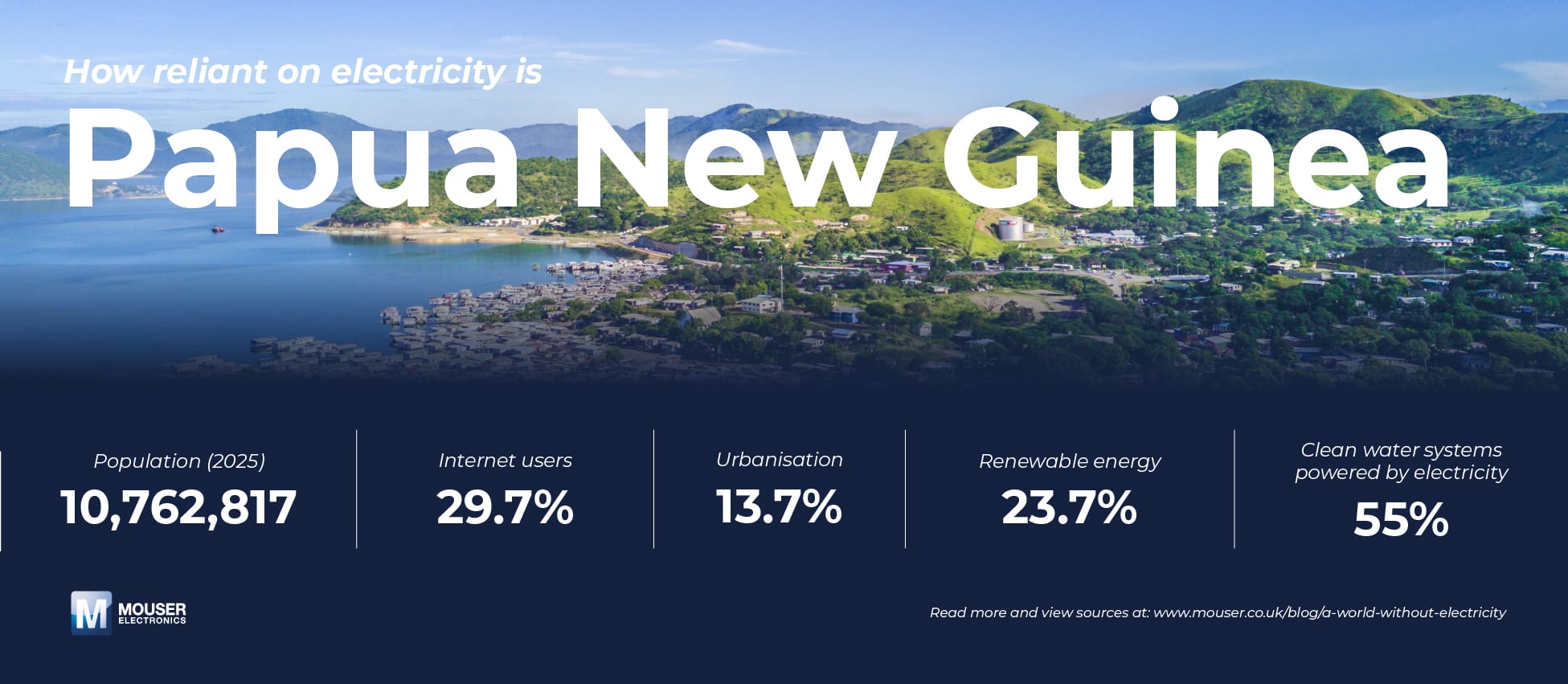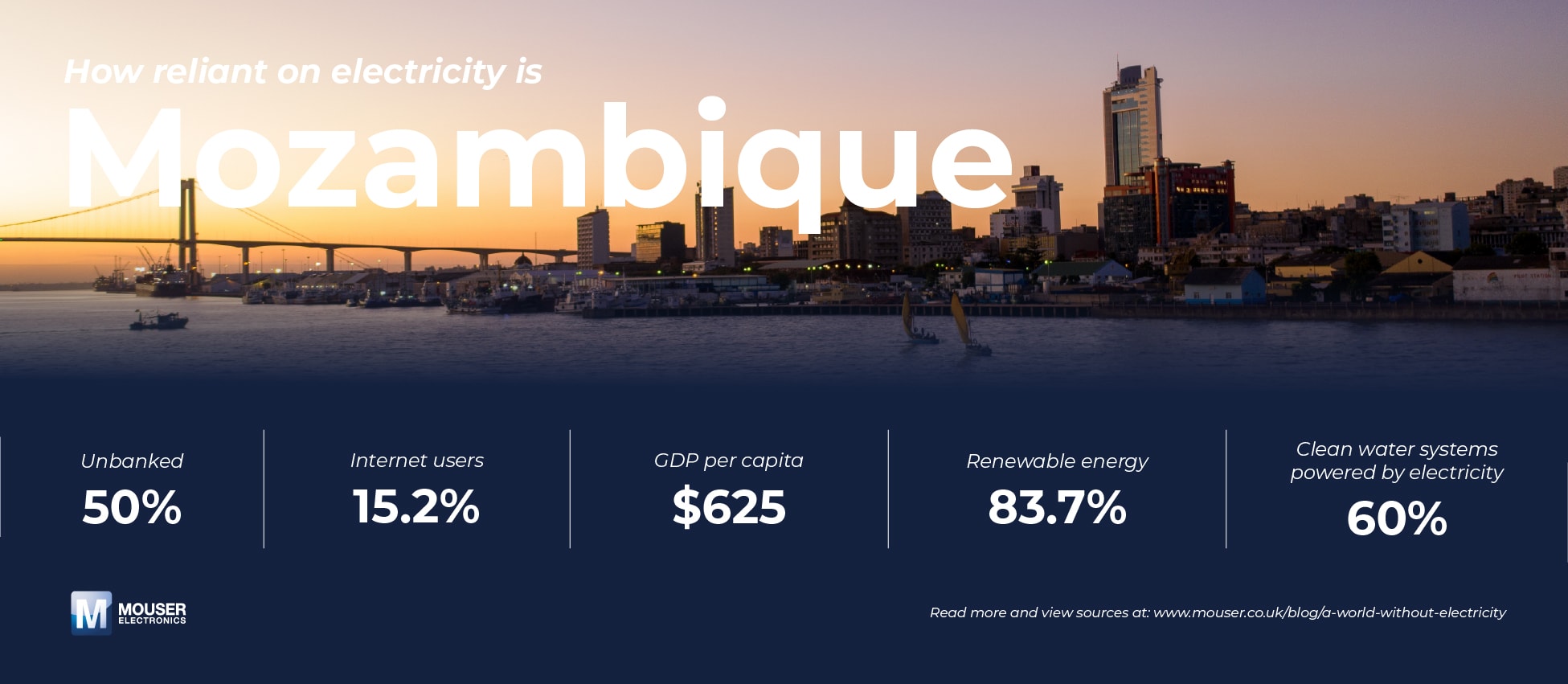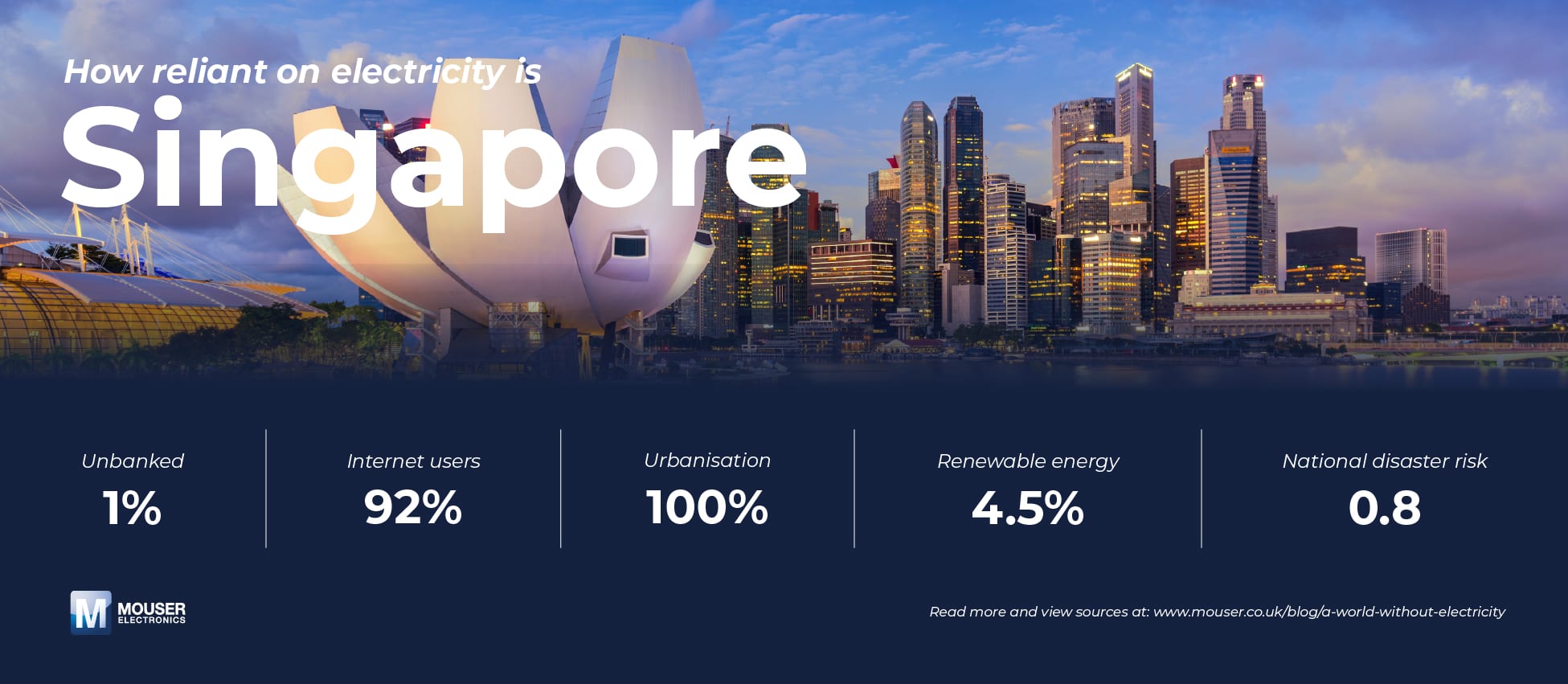A World Without Electricity: How Prepared Are Countries to Cope?

Discover the impact of a prolonged blackout on daily life and some nations’ surprising resilience
Image Source: Joseph Mohmd on Unsplash
By Mark Patrick, Mouser Electronics
We rely on electricity for almost every part of modern daily life, from the obvious, such as turning the lights on in our homes, to the essentials we may not realise require electricity, such as clean running water.
When power fails, battery efficiency becomes critical. This blog presents a thought experiment, imagining how societies might cope in the event of a prolonged power outage, based on current infrastructure and preparedness.
General Effects of a National Blackout
Imagine the lights go out, not just in a city, but across an entire country—no power for homes, hospitals, or businesses. While power outages are challenging, many nations are taking proactive steps to build resilience in the face of disruption, such as investing in renewable energy sources, modernising their power grids, and developing energy storage technologies.
To explore how countries are preparing for such scenarios, Mouser Electronics commissioned a study to analyse data on electricity use, banking access, internet reliance, urbanisation, emergency backups, economic strength, disaster preparedness, and clean water supply for over 200 countries. Together, these criteria created a resilience score intended to reveal how long nations could continue essential daily operations without electricity.
But what could a world in a widespread power outage look like?
Instant: The First Few Hours of No Electricity
Within minutes, homes, streets, and cities go dark. Traffic lights fail, trains halt, and airports experience widespread disruptions. Internet, phones, and landlines cut out. Emergency services struggle to communicate. Hospitals switch to generators, but most last only a few hours to a few days at most.
1–3 Days of a Blackout
If the blackout continued for a couple of days, food and water supplies would become disrupted. Supermarkets rely on refrigeration, and food spoils fast. Sewage treatment centres would shut down, leading to unsafe drinking water. There would also be no ATMs, card payments, or digital transactions.
1–2 Weeks Without Power
After a week or two, supply chains would fail, as there would be no refrigerated transport, no functioning factories, and no restocking shops. Sanitation would break down as waste collection stops and water becomes contaminated. Medicines would become unsafe to use due to a lack of refrigeration, and drug manufacturers would not be able to produce new ones.
Long-Term: A Few Months of No Electricity
After weeks or months, economies would collapse as banks, markets, and businesses grind to a halt. Without farming machinery, refrigeration, or transport, food production and distribution fail.
Although it’s unlikely that something like this would happen—or last so long if it did—there have been at least four significant power outages worldwide in 2025, including the widely discussed Iberian Peninsula blackout, which affected approximately 60 million people.[1]
The Surprisingly Resilient Countries Embracing Electrical Independence
Which countries are actively building resilience to power outages? To discover this, the study’s researchers analysed data on electricity use, banking access, internet reliance, urbanisation, emergency backups, economic strength, disaster preparedness, and clean water supply.

Figure 1: An electricity blackout animation highlights the countries that are likely to be most resilient after losing power. (Source: Mouser Electronics)
No Electricity Is Only a Minor Inconvenience for Papua New Guinea

The amount a country depends on electricity overall can be the simplest measure of its resilience to a total loss of electrical power. While no country in the world is entirely without electricity, many comparatively rural countries would be more resilient. For example, Papua New Guinea uses only 20.5kWh of electricity per capita annually, as many communities operate with minimal reliance on the grid.[2] Large rural populations sustain themselves through largely manual farming, markets, and water collection.
Limited Dependence on Electricity Means Resilience to Power Loss for Mozambique

Mozambique offers a clear example of how limited dependence on electricity can translate into a form of resilience in the face of complete power loss. Although access to electricity has grown, much of the population continues to live off the grid, relying on manual farming, local markets, and community trade.[3] This low level of dependence means that daily life in rural areas could continue with relatively little disruption during a blackout. However, in urban centres such as Maputo and Beira, where hospitals, water systems, and businesses are tied to the grid, the impact would be far more severe. Mozambique’s situation, much like that of other low-consumption nations, shows that resilience often stems not from strong infrastructure, but from a way of life that already operates largely independently of it.
No Power Means No Data
Many countries’ high resilience is not particularly due to strong infrastructure, but because much of their daily life is already lived off-grid. In lower-income countries, per capita electricity use can be as low as 15kWh per year—less than a UK household uses in a day.[4] Over 1.4 billion adults worldwide lack access to traditional banking services such as online banking or credit cards from regulated financial institutions (i.e., unbanked). Over 80 percent of those unbanked people live in low- and middle-income countries, compared to under 2 percent in parts of Europe.[5] With limited hospitals and emergency services available to the population, the challenge isn’t adapting; it’s that life is already precarious. Blackouts would still be devastating, just differently than in other parts of the world.
The Power-Reliant Nations at Most Risk in a World Without Electricity
Conversely, highly urbanised countries that are heavily reliant on energy infrastructure could be more at risk of collapse in a widespread power outage.
Singapore Is Among the Most Power-Reliant Nations

Singapore, as a city-state built on digital connectivity, has 100 percent urbanisation and near-universal internet access (92 percent).[6] A blackout in Singapore wouldn’t just cut lights; essentials like air conditioning and water pumping would fail instantly. And it would halt finance, transport, and daily activity in a tropical climate.
This pattern holds across nations with high levels of development and infrastructure. Singapore, Switzerland, Denmark, the Netherlands, and the UK would quickly experience difficulties without power, due to their high levels of development and extreme dependence on electricity.
That said, many of these countries are actively striving for change in this area. Singapore is strengthening its energy resilience by expanding renewable energy and diversifying supply. As of 2024, it had 1.35 gigawatt-peak (GWp) of solar capacity from rooftop and floating installations. The country is also trialling hydropower imports from Laos, with plans to import 4–6GW of low-carbon electricity by 2035.[7]
Czech Republic Balances Connectivity and Resilience

The Czech Republic mixes high digital reliance (e.g., internet use of 86 percent) and weaker economic resilience (e.g., 2024 GDP per capita of US$31,706).[8] This disparity suggests that while the country is well-connected, its economic structure may not be as robust, which could affect its ability to maintain services during prolonged power outages.
The Czech Republic is boosting resilience by expanding community solar and energy-sharing projects, reducing reliance on the national grid.[9]
How Reliant on Electricity Is the UK?
With over 96 percent of its population online, the UK’s banking, healthcare, and retail sectors are deeply dependent on electricity.[10] Per capita electricity use is over 100 times higher than in nations like Burundi or South Sudan.[11] With less than 2 percent of UK residents unbanked, almost all transactions rely on power.[12] A prolonged blackout would paralyse the economy far faster than in less connected nations.
Over 84 percent of the UK population lives in urban areas, making water, food, and transport heavily reliant on electricity.[13] Hospitals have generators, but coverage is patchy; smaller facilities could see life-threatening gaps in care.
Ultimately, the UK’s electricity dependence enables high living standards but also reveals how vital efficiency and preparedness are in maintaining them.
When Connectivity Creates Fragility
In digitally advanced countries where over 85 percent of the population is online, systems from banking to healthcare rely heavily on power. Even with backup generators, hospitals and other critical infrastructure can function only for a limited period.
In a world where nearly all systems hinge on power, efficiency is critical. Innovations in advanced electronic components enable devices to run longer, bridging the gap between dependence and resilience and helping societies withstand disruption if the grid goes dark.
Methodology
This study, commissioned by Mouser Electronics, analysed countries’ reliance on electricity for day-to-day operations.
The study examined the following key indicators:
- Electricity use per person: higher use means greater reliance
- Unbanked population: less dependence on digital financial systems
- Internet penetration: higher usage increases vulnerability during outages
- Urbanisation: a heavier reliance on power-dependent infrastructure
- Hospital backup generators (desk research): fewer generators reduce resilience
- Hospitals functioning without power (desk research): existing ability to operate without electricity
- GDP per person: financial resources to adapt
- Disaster risk: a higher risk may also mean greater preparedness
- Share of renewable energy: more renewables boost resilience
- Use of electric water pumps (desk research): increased dependency
The full data set is available upon request from MediaRelationsEMEA@mouser.com.
Sources
[1]https://www.euronews.com/my-europe/2025/10/03/obsolete-electricity-grid-triggered-blackout-in-portugal-and-spain-experts-reveal; https://www.bbc.com/news/articles/c8d92n28pqjo; https://abcnews.go.com/International/puerto-rico-plunged-darkness-island-wide-blackout-hits/story?id=120884304; https://havanatimes.org/features/more-than-half-of-cuba-without-power/
[2]https://data.worldbank.org/indicator/EG.ELC.ACCS.ZS?locations=PG
[3]https://data.worldbank.org/indicator/EG.ELC.ACCS.ZS?locations=MZ
[4]https://data.worldbank.org/indicator/EG.USE.ELEC.KH.PC?locations=XM
[5]https://www.worldbank.org/en/publication/globalfindex
[6]https://worldpopulationreview.com/country-rankings/most-urbanized-countries; https://worldpopulationreview.com/country-rankings/internet-users-by-country
[7]https://www.globalbioenergy.org/the-rise-of-renewable-energy-in-sg-what-you-need-to-know-in-2025/
[8]https://worldpopulationreview.com/country-rankings/internet-users-by-country; https://data.worldbank.org/indicator/NY.GDP.PCAP.CD?locations=CZ
[9]https://www.euki.de/en/from-solar-roofs-to-shared-power-pioneering-community-energy-in-czechia/
[10]https://worldpopulationreview.com/country-rankings/internet-users-by-country
[11]https://data.worldbank.org/indicator/EG.USE.ELEC.KH.PC
[12]https://www.worldbank.org/en/publication/globalfindex
[13]https://worldpopulationreview.com/country-rankings/most-urbanized-countries